Preventive nutrition
Preventive nutrition is a branch of nutrition science with the goal of preventing or delaying or reducing the impacts of disease and disease-related complications.[2] It is concerned with a high level of personal well-being, disease prevention, and diagnosis of recurring health problems or symptoms of discomfort which are often precursors to health issues.[3]Preventive nutrition may assist in prolonging the onset of non-communicable diseases (such as Type 2 diabetes or cardiovascular disease) and may allow adults to experience more "healthy living years"[4] later in life.[5][4] The need for preventive nutrition continues to grow as the overweight and obese population numbers steadily rise within the childhood to adult populous, as the numbers have increased over the last 40 years. [4] To educate the public about preventive nutrition, each social structure has its own way to communicate what preventive nutrition is within its own society, this is done through either a public health forum, government programs and policies or nutritional education.[6] In the United States of America preventive nutrition is taught to the public through the use of the food pyramid or my plate initiatives.[6]

History
The idea of using preventive nutrition as a medical treatment is not a new idea, as philosopher Hippocrates (460-377 BC) states that the best way to diminish diseases or ailments was to " Let food be your medicine and medicine be your food". [4] Since the understanding for preventive nutrition was needed, the Mediterranean Diet model was the standard reference guide.[5] As the Mediterranean diet was initially recognized to fight against the onset of heart disease. [5]
Since the early nineteen-eighties food trends have gradually begun to change, with the introduction and fast popularization of processed prepackaged convenience foods.[4][5][6] With this popularization these type of foods also increased the digestions of high amounts of sugar, sodium and high fatty foods which have a lower nutrient-density value that can have great adverse effects on health.[7]
Related Topics
- Preventive healthcare
- Dietitian is an expert in Dietetics and specializes in human nutrition.
- Animal nutritionist specializes in animal nutrition
- Physical Activity
- Hippocrates
- The Food Pyramid
- Mediterranean Diet and Mediterranean Diet Pyramid
- Non-communicable diseases
References
- Nicola Di Daniele. (2019). The Role of Preventive Nutrition in Chronic Non-Communicable Diseases. Nutrients, 11(5), 1074.
- "Preventive Nutrition - Department of Nutrition and Food Studies". chhs.gmu.edu. Archived from the original on 31 January 2017. Retrieved 30 April 2017.
- "What is Preventive Nutrition?". Nutritional Concepts. Archived from the original on 12 July 2018. Retrieved 30 April 2017.
- Fardet, A., & Rock, E. (2014). Toward a new philosophy of preventive nutrition: From a reductionist to a holistic paradigm to improve nutritional recommendations. Advances in Nutrition (Bethesda, Md.), 5(4), 430-446.
- Nicola Di Daniele. (2019). The Role of Preventive Nutrition in Chronic Non-Communicable Diseases. Nutrients, 11(5), 1074.
- Fardet, A., & Rock, E. (2016). The healthy core metabolism: A new paradigm for primary preventive nutrition. The Journal of Nutrition, Health & Aging, 20(3), 239-247.
- Ritchie, L., Wakimoto, P., Woodward-Lopez, G., Thompson, F., Loria, C., Wilson, D., . . . Webb, K. (2015). The Healthy Communities Study Nutrition Assessments. American Journal of Preventive Medicine, 49(4), 647-652.